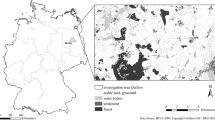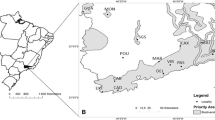Abstract
The response variable (often the presence of a species) in predictive habitat models relies on a set of environmental predictors. Among all known environmental predictors, vegetation has the most effect on species abundance and on their habitat preferences, due to the wide range of necessary resources that it provides for the survival of bird species. However, other predictors, in turn, affect bird distribution, and some-times they play a more important role in habitat selection, depending on the natural history and ecological needs of the bird species. In this regard, different analyses have been conducted to predict the distribution, and define habitat suitability (such as discriminant function analysis, General Linear Models, and ANOVA). In this study, all three analytical designs were used to investigate the relationship of seven bird species to the major environmental gradients in the study area, to find out the significance of each of these factors on habitat selection. GIS has been used to prepare spatial distributional data, and to overlay and calculate different aspects of the environmental factors. The results suggest that potential individual habitat patches play a small role compared to the landscape (entire corresponding habitat patches), when considering vegetation. The influence of built-up areas is significant for all the species, and the proximity to the sea shore is very significant for at least one of the species, however, it is not neutral for all other species.
Similar content being viewed by others
References
Austin, G.E., Thomas, C.J., Houston, D.C., and Thompson, D.B.A., Predicting the Spatial Distribution of Buzzard (Buteo buteo) Nesting Areas Using a Geographical Information System and Remote Sensing, J. Appl. Acol., 1996, vol. 33, pp. 1541–1550.
Dale, V.H., Brown, S., Haeuber, R.A., Hobbs, N.T., Huntly, N., Naiman, R.J., Riebsame, W.E., Turner, M.G., and Valone, T.J., Ecological Principles and Guidelines for Managing the Use of Land, Ecol. Appl., 2000, vol. 10, pp. 639–670.
Dettmers, R. and Bart, J., A GIS Modeling Method Applied to Predicting Forest Songbird Habitat, Ecol. Appl., 1999, vol. 9, no. 1, pp. 152–163.
DSE (Department of Sustainability and Environment), 1997. URL: http://www.dse.vic.gov.au/dse/nrence.nsf/LinkView/E7B9CDDDF60D2EE3CA256F2B000190F98062D358172E420C4A256DEA0012F71C. Last viewed February 27, 2006.
Ferwerda, F., Assessing the Importance of Remnant Vegetation for Maintaining Biodiversity in Rural Landscapes Using Geospatial Analysis, Masters of Applied Science (Geospatial Information) Thesis, RMIT University, Australia, 2003.
Guisan, A. and Zimmermann, N.E., Predictive Habitat Distribution Models in Ecology, Ecol. Model., 2000, vol. 135, pp. 147–186.
Lavers, C.P. and Haines-Young, R.H., Using Models of Bird Abundance to Predict the Impact of Current LandUse and Conservation Policies in the Flow Country of Caithness and Sutherland, Northern Scotland, Biol. Conserv., 1996, vol. 75, pp. 71–77.
Leathwick, J.R., Climatic Relationships of Some New Zealand Forest Tree Species, J. Veget. Sci., 1995, vol. 6, pp. 237–248.
Morrison, M.L., Marcot, B.G., and Mannan, R.W., Wildlife-Habitat Relationships: Concepts and Applications, 2nd ed., Madison: University of Wisconsin Press, 1998.
Mourell, C. and Ezcurra, E., Species Richness of Argentine Cacti: A Test of Biogeographic Hypotheses, J. Veget. Sci., 1996, vol. 7, pp. 667–680.
Osborne, P.E. and Tigar, B.J., Interpreting Bird Atlas Data Using Logistic Models: An Example from Lesotho, Southern Africa, J. Appl. Ecol., 1992, vol. 29, pp. 55–62.
Saab, V., Importance of Spatial Scale to Habitat Use by Breeding Birds in Riparian Forests: A Hierarchical Analysis, Ecol. Appl., 1999, vol. 9, pp. 135–151.
Scott, J.M., Davis, F., Csuti, B., Noss, R., Butterfield, B., Groves, C., Anderson, H., Caicco, S., D’erchia, F., Edwards, T.C. Jr., Ulliman, J., and Wright, R.G., Gap Analysis: A Geographic Approach to Protection of Biological Diversity, Wildlife Monogr., 1993, vol. 123, pp. 1–41.
Simpson, K. and Day, N., Field Guide to the Birds of Australia, Ringwood, Victoria: Penguin Books, 2004.
Tyre, A.J., Possingham, H.P., and Lindenmayer, D.B., Matching Observed Pattern with Ecological Process: Can Territory Occupancy Provide Information about Life History Parameters?, Ecol. Appl., 2001, vol. 11, pp. 1722–1738.
Author information
Authors and Affiliations
Corresponding author
Additional information
The article is published in the original.
Rights and permissions
About this article
Cite this article
Shabani, A.A., McArthur, L.C. & Abdollahian, M. Comparing different environmental variables in predictive models of bird distribution. Russ J Ecol 40, 537–542 (2009). https://doi.org/10.1134/S1067413609070133
Received:
Published:
Issue Date:
DOI: https://doi.org/10.1134/S1067413609070133




